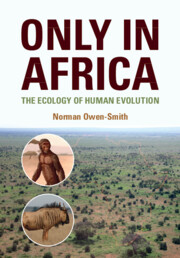Book contents
- Only in Africa
- Only in Africa
- Copyright page
- Dedication
- Contents
- Foreword
- Preface
- Abbreviations
- Part I The Physical Cradle: Land Forms, Geology, Climate, Hydrology and Soils
- Part II The Savanna Garden: Grassy Vegetation and Plant Dynamics
- Chapter 6 Forms of Savanna: From Woodland to Grassland
- Chapter 7 How Trees and Grasses Grow and Compete
- Chapter 8 Plant Demography and Dynamics: Fire Traps
- Chapter 9 Paleo-savannas: Expanding Grasslands
- Part II Synthesis: Savanna Structure and Dynamics
- Part III The Big Mammal Menagerie: Herbivores, Carnivores and Their Ecosystem Impacts
- Part IV Evolutionary Transitions: From Primate Ancestors to Modern Humans
- Appendix Scientific Names of Extant Animal and Plant Species Mentioned in the Book Chapters (Ecologically Conservative with Regard to Species Recognition)
- Index
Part II - Synthesis: Savanna Structure and Dynamics
from Part II - The Savanna Garden: Grassy Vegetation and Plant Dynamics
Published online by Cambridge University Press: 09 September 2021
- Only in Africa
- Only in Africa
- Copyright page
- Dedication
- Contents
- Foreword
- Preface
- Abbreviations
- Part I The Physical Cradle: Land Forms, Geology, Climate, Hydrology and Soils
- Part II The Savanna Garden: Grassy Vegetation and Plant Dynamics
- Chapter 6 Forms of Savanna: From Woodland to Grassland
- Chapter 7 How Trees and Grasses Grow and Compete
- Chapter 8 Plant Demography and Dynamics: Fire Traps
- Chapter 9 Paleo-savannas: Expanding Grasslands
- Part II Synthesis: Savanna Structure and Dynamics
- Part III The Big Mammal Menagerie: Herbivores, Carnivores and Their Ecosystem Impacts
- Part IV Evolutionary Transitions: From Primate Ancestors to Modern Humans
- Appendix Scientific Names of Extant Animal and Plant Species Mentioned in the Book Chapters (Ecologically Conservative with Regard to Species Recognition)
- Index
Summary
The ecology of savanna vegetation in Africa is governed largely by the ecology of grasses. Savanna grasses with the C4 photosynthesis pathway are superbly adapted to cope with erratic rainfall. They can grow rapidly during times when soil moisture is adequately available, exploiting pulses of nutrient release while overcoming the limitation on growth by low atmospheric concentrations of carbon dioxide. Hence they can out-compete tree seedlings in extracting soil water from the topsoil layer where most nutrients occur. For juvenile trees to establish amid the dense mat of grass roots, they must extend their roots to greater depths in the soil and expand their growth to times earlier and later in the wet season than grasses. Tree saplings are repeatedly set back by having the accumulated carbon burnt back. To escape the fire trap, tree saplings must build up sufficient resources below ground to enable them to elevate their foliage above the flame zone. Grasses lose only dead top-hamper to fires and suffer from its accumulation in the absence of fires or grazing. Grasses grow both beneath and between tree canopies. Dense evergreen foliage would be required to shade out grasses, but such trees are restricted to locations that seldom burn.
- Type
- Chapter
- Information
- Only in AfricaThe Ecology of Human Evolution, pp. 138 - 140Publisher: Cambridge University PressPrint publication year: 2021

